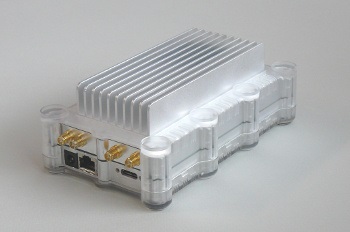WinRadio has just added a new SDR to their line-up: the Winradio WR-G69DDCe ‘Artemis’.
In the spirit of WinRadio’s approach to iterative design, the Artemis appears to be their new flagship SDR. The specs and features (see below) are impressive.
The WR-G69DDCe has two (selectable, I assume) frequency ranges. In “Range 1” it operates as a direct sampling SDR from 8 kHz to 80 MHz. In “Range 2” it operates as a superheterodyne receiver from 43 MHz to 8 GHz.
It appears the WR-G69DDCe’s recording and processing bandwidth is an impressive 32 MHz. I imagine it would take some proper CPU horsepower and a large, speedy SSD to make those 32 MHz recordings!
At time of posting, I haven’t seen details about pricing and availability, but I’m 99% certain this will not be a budget model. WinRadio’s higher performance SDR models have historically retailed in excess of $2,000 US.
The following details were taken directly from the Winradio WR-G69DDCe product page:
Overview
The WiNRADiO WR-G69DDC ‘Artemis’ is a top performance, software-defined, wide-band, ultra-fast search speed 3 GHz/s, HF/VHF/UHF/SHF receiver. Two independent and mutually exclusive inputs are provided, one for each range: 8 kHz to 80 MHz and 43 MHz to 8 GHz. A real-time 80/34 MHz-wide spectrum analyzer is included with a 32 MHz wide instantaneous bandwidth available for recording, demodulation and further digital processing over the whole frequency range.
The receiver’s superior performance results from its innovative, combination of direct-sampling and superheterodyne, digital down-conversion architecture along with the use of leading-edge components and design concepts. These all result in excellent sensitivity, phase noise and dynamic range, highly accurate and stable tuning, high scanning speed and perfect demodulation. These key features create a receiver in a class of its own, making it capable of filling not only the role of a monitoring receiver but also that of a fast search receiver and measuring receiver, with many operational and instrumentation features not usually found on receivers of any price category.
The entire 32 MHz DDC (digitally down-converted) bandwidth is available for recording and demodulation, and ideal for hopping frequencies analysis. Three demodulators allow the simultaneous reception and decoding of radio signals within the entire band.
The WR-G69DDCe also features optional external reference frequency inputs and outputs as well as 1PPS pulse input. In addition, stereo analog output is also possible, as well as wide audio (10 Hz-150 kHz). The special data port offers numerous possibilities which include GPIO (general purpose I/O), HSP (high speed data output), or traditional RS232 interface.
Features
-
- 8 kHz to 8 GHz frequency range
- Direct sampling & superheterodyne
- Digital down-conversion
- 16-bit 200 MSPS A/D converter
- 80/34 MHz-wide, real-time spectrum analyzer
- 32 MHz recording and processing bandwidth
- Continuously adjustable filter bandwidth down to 1 Hz
- Waterfall display functions and audio spectrum analyzer
- Audio and IF recording and playback
- Recording with pre-buffering
- Ultra-fast search speed 3 GHz/s
- High sensitivity
- Excellent dynamic range
- Excellent frequency stability (0.1 ppm)
- Test and measurement functions
- Networking version of application software available
- USB 3.0 and 1 Gb Ethernet (with PoE) data interfaces
- Numerous data and signal hw options
- Self-diagnostics with BIT and thermal management
- The receiver interfaces to a Windows-compatible PC via USB 3.0, or 1 Gb Ethernet LAN port with PoE (Power over Ethernet functionality according to the IEEE 802.3at standard).
For the highest bandwidth use, connection is best via USB3 for short distances (up to 3m). As the G69DDCe is equipped with an Ethernet socket, semi-remote connection to a computer is possible via a long Ethernet cable (up to 100m in length). For longer distances or when located in a busy or remote network, the Networking CSO option is recommended.
The receiver is very well shielded against interference, making it possible to operate in a noisy computer environment. Its modest power requirements are less than 20 watts. While connected via a LAN interface, thanks to PoE built-in functionality, the receiver can be operated and powered via a long Ethernet cable connection.
I’ll post information about pricing and availability once it’s available. Stay tuned!

